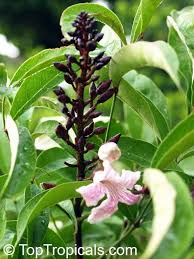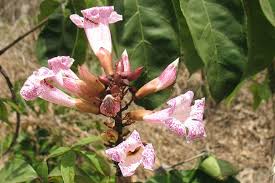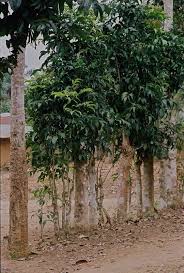Newbouldia laevis (P.Beauv) seem.
| Botanical Name | Newbouldia laevis (P.Beauv) seem. |
| Order: | Lamiales |
| Family: | Bignoniaceae |
| Genus: | Newbouldia |
| Species: | N. laevis |
| Common Names: | Tree of life, Fertility tree |
Plant Synonyms
Plant Local Names
NIGERIA: Yoruba - akoko, Igbo - Ogilisi
Plant Habitat
Secondary forest, often planted
Plant Material of Interest
Leaves, bark, root, root bark, stem bark
Plant Description
Tree is up to 18m high, 60- 90cm in girth. Bark greyish to pale brown, fairly smooth, slash cream, fibrous. Branchlet short and twisted, with short knobby twigs often with clustered leaves at their ends. Leaves are up to 50cm long and usually with 3- 5 pairs of leaflets. The common stalk being prominently swollen at the point of attachment of each pair, leaflets 15- 20cm long by 5- 10cm broad, elliptic to broadly elliptic, sometimes slightly oblanceolate, acuminate, cuneate rather leathery, dark green, glabrous, usually with coarse teeth but the margin sometimes entire with 5- 8 pairs of prominent lateral nerves, looped well away from the margin, leaflet stalk very short, stout. Flowers (Dec- Feb) purplish- pink with darker stripes, trumpet shaped, up to 6cm long, closely crowded in almost spike-like panicles at the ends of short side stouts, calyx about 2.5cm long, splitting down one side. Fruits (Jan- Feb) 22- 30cm long, pendulous, surface dotted with purplish glands which are attractive to ants, packed with winged seeds, flat, about 3.5cm long including the wing at each end. Wood is pale brown, moderately hard (Keay et. al., 1964)
Plant Used Parts
Plant Uses
i. Used to stop vaginal bleeding in threatened abortion.
ii. Leaves and roots are boiled together and administered for fever, and convulsion and epilepsy.
iii. Stem bark used for treating skin infections.
iv. Chieftaincy leaf in Yoruba land
v. Leaves used in decoction as an eye wash in conjunctivitis.
vi. Boiled leaves extract used to bath to treat general malady.
vii. Roots used as round worm vermifuge and stomachic for migraine and ear ache (Ognochukwu, 2005)
Plant Therapeutic Action
Plant Precaution for Use
Plant Adverse Effect
Plant Contraindication
Plant Dosage Forms
Plant Dosage
Plant Storage
Plant Chromatographic Fingerprint
Plant Constituents
Several naphthaquinones have been isolated from the root and stem bark.
These are: lapachol (0.002%), alpha-lapachone (0.00345%, 3-hydroxydehydroiso-lapachone (0.0016%), dehydro-alpha-lapachone (0.0014%), 5-hydroxy-7-methoxydehydro-alpha-lapachone (0.000052%), dehydro-iso-alpha-lapachone (0.00092%), 3,8-dihydroxy-iso-alpha-lapachone (0.00256%), 3-hydroxy-5-methoxydehydro-iso-alpha-lapachone (0.00043%), 3-hydroxydehydro-iso-alpha-lapachone (0.00015%), 5-methoxydehydro-iso-alpha-lapachone (0.00369%), 6-hydroxydehydro-iso-alpha-lapachone (0.00067%), naphtha-[2,3-b]-furan-4,9-dione (0.00028%) and 2-isopentyl-8-hydroxynaphtho-[2,3-b]-furan-4,9-dione (0.00016%), 2-acetyl-5-hydroxynaphtho-[2,3-]-furan-4,9-dione (0.0037%), 2(l’-methylethenyl)-5-hydroxynaphtho-[2,3-b]-furan-4,9-Quinnone (0.0004%) have been isolated from the stembark. Other compounds are 7-hydroxydehydroisomartynoside (0.00062%), newbouldioside, verbacoside, alkaloids such as 2-(l’-methylethenyl-newbouldioside) from the root, newbouldine, 4’-hydroxynewbouldine, 4’-methoxynewbouldine, withasomnine, 4’-hydroxywithasomnine, 4’-methoxywithasomnine [rootbark] (Quinnn, 2005), newbouldioside A-D, phenyethanoid glycosides from stembark (Gorman et, al., 2005), tartaric acid, 2-(l’-methylethenyl-6-hydroxy-2-3-dihydrobenzofuran, and furanonaphthaQuinnones [2-(l’-methylethen)-5-hydroxynaphtho-[2,3-b-]-furan-4,9-dione, and 2-(l’-methylethenyl)-7-hydroxynaphtho-[2,3-b]-furan-4,9-dione (Rukangira, 2001).



